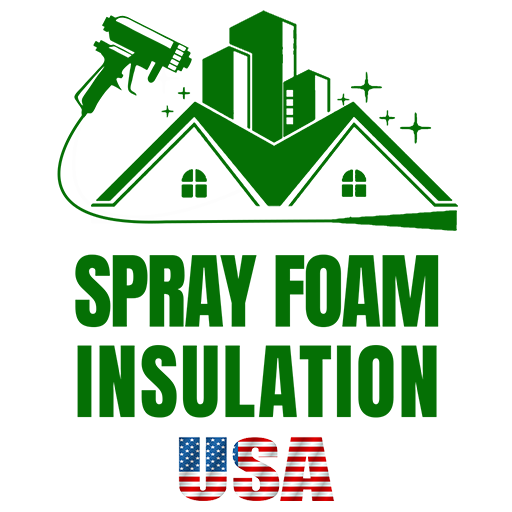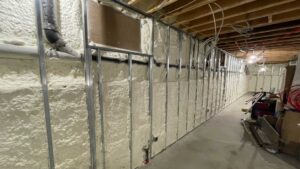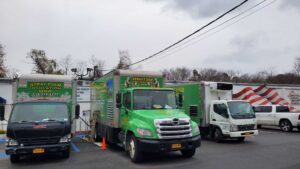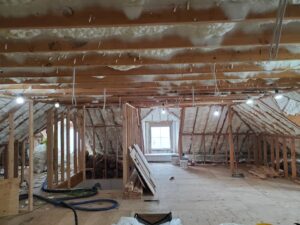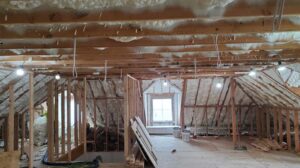Introduction
Are residential power lines insulated? The quick answer is typically no. Most residential overhead power lines are bare, meaning they lack a protective insulating cover. They rely instead on the air around them for insulation, which sufficiently prevents the electricity from arcing or leaking under normal circumstances.
Understanding why this method is effective and what safety measures are in place is crucial for homeowners looking to grasp the fundamentals of residential electrical systems. This introduction will briefly explore basic electricity concepts and address common safety concerns associated with residential power lines.
Electricity in overhead power lines travels through conductors that, contrary to what one may think, are usually not covered by any insulating material. This might sound unsafe at first, but the design relies on the natural insulating properties of air and the strategic placement of these lines away from easy reach. Additionally, other mechanisms like service masts and strain relief cables play a role in ensuring these high voltages never pose a threat to residential safety.

By understanding these elements, residents can better appreciate the meticulous considerations made to balance cost, efficiency, and safety in the power delivery infrastructure. As we delve deeper into these aspects, we’ll uncover more about why certain myths persist and how modern practices ensure safety without the need for physical wire insulation.
The Composition of Residential Power Lines
When it comes to the structure of residential power lines, several key materials play crucial roles. These include aluminum, copper, bare wires, and porcelain insulators. Each component has its specific function that ensures the safe and efficient transmission of electricity to our homes.
Aluminum and Copper
Most residential power lines are made from aluminum or copper. These metals are favored for their excellent conductivity, which means they can carry electrical current very efficiently. Aluminum is lighter and generally less expensive than copper, making it a popular choice for many utility companies. However, copper is more conductive and durable, which can be beneficial in areas with severe weather conditions or where higher conductivity is needed.
Bare Wires
Surprisingly, many residential power lines are composed of bare wires. These are not covered with any insulating material. The reason for this is twofold: cost-effectiveness and heat dissipation. Insulating materials can be expensive, and they can also trap heat generated by electrical resistance. Bare wires allow for easier heat dissipation into the surrounding air, which helps maintain the efficiency of the power transmission.
Porcelain Insulators
To prevent electrical currents from unintentionally grounding, porcelain insulators are used to support these bare wires on poles. Porcelain is an excellent insulator — it does not conduct electricity and can withstand the environmental stresses of outdoor use. These insulators are typically white and can be seen as the disk or cylindrical shapes that separate the wires from the poles and each other.
Understanding these components helps residents recognize the careful planning and consideration that goes into the design and maintenance of our electrical infrastructure. These materials are chosen not only for their functional properties but also for their ability to ensure long-term safety and reliability in delivering power to our homes. We’ll explore some common misconceptions about power lines and address why certain safety measures are perceived differently.
Insulation and Safety of Power Lines
When discussing the safety and construction of residential power lines, understanding whether are residential power lines insulated and how this impacts their functionality and safety is crucial. Let’s delve into the key aspects of insulation, electrical leakage, environmental threats, and the role of air and distance as insulators.
Insulated vs. Uninsulated
Contrary to what many might think, most residential power lines are uninsulated. These bare wires are exposed without any protective sheathing, relying instead on the air around them to act as an insulator. This might sound unsafe at first, but there are practical reasons behind this design choice.
Electrical Leakage
One might wonder, with the wires being bare, isn’t electrical leakage a major risk? Interestingly, the air provides sufficient insulation to prevent leakage under normal conditions. Power lines are placed high enough and spaced adequately on poles to minimize the risk of electrical discharge to nearby objects.
Environmental Threats
Environmental factors like wind, ice, and fluctuating temperatures pose significant challenges to power lines. Insulation materials, if used, would add considerable weight and could lead to increased sagging or even snapping of the wires under extreme conditions. The absence of a heavy insulating layer allows these lines to withstand environmental stresses better by reducing the load.
Air and Distance as Insulators
The principle of using air as an insulator is quite effective. Air is a poor conductor of electricity, making it an excellent insulator for the high voltages carried by overhead power lines. The significant distance between the wires and the ground, or between the wires themselves on poles, further ensures that the electrical path does not find an unintended route to the ground or across phases.
Understanding these aspects helps clarify why power lines are designed the way they are. While it may seem counterintuitive at first to leave such powerful conductors bare, the reasons are grounded in practicality and safety considerations. This design approach minimizes risks while maximizing efficiency and durability in the face of environmental and operational demands.
As we progress, we’ll tackle some common misconceptions about power lines, including why birds can perch safely on live wires and myths surrounding the insulation of these lines. This will provide a clearer picture of the everyday safety and operational standards of the electrical infrastructure surrounding us.
Common Misconceptions About Power Lines
When it comes to are residential power lines insulated, there are several myths and misunderstandings that can cause confusion. Let’s clarify some of the most common misconceptions about power lines to ensure you have the correct information.
Birds and Electrocution
Myth: Birds get electrocuted on power lines all the time.
Fact: Birds can sit on power lines without harm. This is because electricity seeks the path of least resistance to the ground. Since birds aren’t touching the ground or another conductor, they don’t create a path for electricity, and thus remain unharmed.
Non-metal Ladders
Myth: Only metal ladders conduct electricity, so non-metal ladders are safe around power lines.
Fact: All ladders, regardless of material, can conduct electricity if conditions are right, such as when they are wet or dirty. It’s crucial to keep all ladders away from power lines by at least 10 feet, as electricity can ‘jump’ or ‘arc’ to a conductor nearby.
Proximity Dangers
Myth: If you maintain a safe distance from power lines, you’re completely safe.
Fact: While keeping distance is key, under certain conditions, such as high humidity or damaged wires, electrical arcs can occur unexpectedly. Always assume power lines are dangerous and maintain a safe distance, ideally more than the recommended 10 feet.
Insulation Myths
Myth: Power lines are insulated like the wiring in your home.
Fact: Most residential power lines are not insulated. The wires are bare and use the surrounding air as insulation. This is why it’s dangerous to assume they are safe to touch or approach closely. Any contact with these lines can result in severe injury or death.
Understanding these facts helps clarify why certain safety protocols are in place and emphasizes the importance of adhering to them. Always consult with professionals if you are unsure about the safety of an activity near power lines.
We’ll delve into the specifics of residential electrical service drops and their critical role in home electrical systems.
Frequently Asked Questions about Residential Power Lines
Why don’t birds get electrocuted on power lines but humans do?
Birds often perch on power lines without harm, and this puzzles many people. The reason birds do not get electrocuted is that they do not create a path to the ground. Electricity always seeks the easiest route to the ground, and as long as the birds are not touching the ground or another wire at the same time, they do not complete an electrical circuit. Humans, on the other hand, are usually in contact with the ground or other potential conductors, which can create a dangerous path for electricity if they touch a power line.
Are residential power lines safe?
Residential power lines are generally safe if left undisturbed. They are designed to transmit electricity efficiently and safely to homes. However, they can become dangerous if damaged or if safety guidelines, such as maintaining a safe distance, are not followed. Residential power lines are typically bare, meaning they are not covered with insulating material. This design helps with heat dissipation and cost efficiency but does mean that direct contact is highly dangerous.
Does electrical wire need to be insulated?
In residential settings, electrical wires within the home are almost always insulated because this prevents accidental contact with the wire which can lead to electrical shocks. However, the high-voltage power lines that run overhead are usually not insulated. This might seem counterintuitive, but the air around these high-voltage lines acts as an insulator. Insulating these wires would be prohibitively expensive and could actually hinder the performance of the power line by trapping heat. Covered line wire is sometimes used in areas where wildlife or environmental conditions pose a greater risk for power line issues.
Let’s explore the specifics of residential electrical service drops and understand their essential role in powering our homes safely and efficiently.
Residential Electrical Service Drops Explained
Service Drop Function
A residential electrical service drop is the point where the utility company’s overhead power lines connect to a home’s electrical system. This connection is crucial as it represents the primary entry point for electricity into your home. Essentially, the service drop funnels electricity from the main utility lines directly into your home’s electrical meter and then to your circuit breaker panel, distributing power throughout your residence.
Overhead vs. Buried Lines
There are two main types of service connections:
– Overhead Service Drops: These are more visible and common in older neighborhoods. The cables descend from a utility pole to your home, typically attaching to a device called a “weather head” on the outside of the building.
– Buried Lines (Service Laterals): Preferred in newer developments for aesthetic and safety reasons, these lines run underground from the utility’s distribution system to the home. They are less susceptible to weather-related disruptions but are more expensive to install and repair.
Parts of a Service Drop
A typical overhead service drop includes:
1. Hot Cables: Usually two insulated wires carrying 120 volts each, combining for a total of 240 volts.
2. Neutral Cable: A bare wire that also provides structural support to the service drop.
3. Service Mast: The metal pipe that extends above your roofline, securing the service drop wires.
4. Weather Head: Positioned at the top of the service mast, it prevents water from entering the service cables.
5. Meter Base: The entry point for the service drop into your home, where usage is recorded.
Service Drop Repairs
It’s crucial to remember that any damage to the service drop can lead to power outages or safety hazards. Common issues like frayed wires or a leaning pole need immediate attention. However, repairs should only be handled by professionals—either from the utility company or a licensed electrician, depending on the component affected.
Height Requirements
For safety and accessibility, electrical codes specify minimum height requirements for overhead service drops. These standards ensure that the wires are high enough to avoid accidental contact with people and objects, such as ladders or tall vehicles. The typical minimum height is about 12 feet over residential driveways and 10 feet over walkways.
Understanding these aspects of your home’s electrical service drop helps in recognizing potential issues and ensures safe and efficient use of your electrical system. Always consult with a professional if you suspect any problems with your service drop to maintain safety and compliance with local electrical codes.
Conclusion
When it comes to the safety and efficiency of your home’s electrical system, the importance of professional insulation cannot be overstated. Proper insulation of residential power lines plays a crucial role in ensuring that energy is used efficiently and safely. Are residential power lines insulated? Typically, the high-voltage lines are not insulated with materials like you see in indoor wiring because they are designed to operate safely in open air, which acts as a natural insulator. However, the transition points and connections within residential setups, where these high voltages convert to usable levels, do need careful and professional insulation to prevent energy loss and protect against electrical hazards.
At Spray Foam Insulation USA, we understand the critical nature of these requirements. Our team of experts specializes in providing top-notch insulation solutions that enhance the safety and energy efficiency of your home. By choosing professional services like ours, you ensure that every aspect of your home’s electrical insulation is handled with precision and care. This not only helps in reducing unnecessary energy consumption but also significantly lowers the risk of electrical accidents.
We encourage all homeowners to recognize the value of professional insulation services. It’s not just about adhering to safety standards; it’s about optimizing your home’s energy use and ensuring peace of mind. The benefits of professional insulation extend beyond immediate safety and also contribute to long-term savings on energy bills.
For more information on how we can help insulate and protect your home, visit our residential insulation services page. Let us help you make your home safer, more comfortable, and energy-efficient.
When it comes to electrical safety and efficiency, never compromise. Trust professionals who understand the intricacies of residential power systems and the critical role of proper insulation. Choose Spray Foam Insulation USA for your home insulation needs and experience the difference that professional expertise makes.

